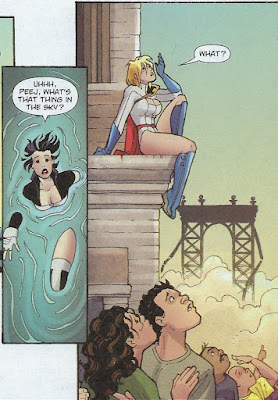Power Girl: Power Trip
 |
|
Collection published: 2023 Contents originally published: 2005-10 Acquired and read: August 2023 |
Inker: Jimmy Palmiotti
When I reread the "Power Trip" arc of JSA Classified (see item #39 in the long list below), I was reminded of how awful Geoff Johns's writing was... but also what a brilliant artist Amanda Conner was, and what a good fit she was for the buoyant, expressive Power Girl. So I decided to pick up this collection, which contains all twelve issues of her run on Power Girl vol. 2. (Unfortunately, it also includes that terrible JSA Classified story, but I skipped it rather than suffer through it a third time. Note that Geoff Johns gets first billing on the cover for writing just four of the seventeen issues included here, whereas Amanda Conner—the only person to work on all seventeen and the volume's clear star—is down in fourth. Must be nice to be the former president of DC!)
The twelve issues of Power Girl collected here run concurrently with Justice Society of America vol. 3 #29-40 and JSA All-Stars vol. 2 #1-6, taking place during the time when Power Girl is leading the JSA. (When the volume opens, the team seems to be unified still; by the time of the closing arc, it has split up, and Magog has left.) But the story's focus is on the fact that despite what's happening with the Justice Society, Power Girl is no longer frustrated at her lack of a clear origin, and just trying to be herself—whoever that may be. So for the first time in a long while, she's reactivated her civilian identity of Karen Starr, and is using it to build a technology company while she moves out of the JSA brownstone into an apartment of her own. She develops friendships, and builds up her own supporting cast. There's even her cat from her JLI days.
 |
| I would not have guessed Wonder Woman was great with cats... except to the extent that she's great at everything, I suppose. from Wonder Woman vol. 1 #600 (script & art by Amanda Conner) |
It's one of those runs that you can't point to a single issue and say "this is an amazing comic book" but where you can point to the whole and say "this is what a superhero comic book should be." It's funny, it's charming, it's goofy, it has a unique personality all its own. Sometimes Power Girl is battling the Ultra-Humanite and his former lover Santana, but sometimes she's stopping alien girls gone wild and a virile alien warlord who wants to repopulate his sterilized planet, sometimes she's helping out a teenage boy by going comic book shopping with him. Writers Justin Gray and Jimmy Palmiotti have admittedly produced some real shit in their time at DC, but this plays to their strengths—or at least to Conner's, who is surely in the Top Ten of superhero comics artists, and consistently elevates any material she is given.
 |
| Bring back Vartox. from Power Girl vol. 2 #12 (script by Justin Gray & Jimmy Palmiotti, art by Amanda Conner) |
In Conner's hands, comedy, action, and emotion all get good play, letting the whole story come alive. Sometimes the main conflict of one of these stories will end halfway through an issue, and the rest will just be about Power Girl chilling with her sidekick/new friend Terra—and it is always a delight. Conner hits the perfect note with PG's physical appearance, giving us a woman who is attractive but not objectified. I mean, Gray and Palmiotti definitely write in gratuitous moments, but they feel natural and part of the story. (Which is not always the case with Power Girl; shortly before writing this review, I read JSA All-Stars #1, where PG's costume gets strategically torn in such a way as to reveal her entire midriff, and where her boobs are always hanging in "attractive" unnatural positions... bleh.)
 |
| My favorite Atlee moment, though, is probably the bit where she pretends to be from Australia. from Power Girl vol. 2 #3 (script by Justin Gray & Jimmy Palmiotti, art by Amanda Conner) |
Like many great runs, the worst thing about it is that it wasn't longer; I gladly would have read another twelve issues from this team. I felt that the supporting cast at Karen's new company barely got started in what they could do, and I want more Kara and Atlee bonding in New York City. But even though this comic lasted another fifteen issues, Judd Winick took over as writer and it became (to my understanding, anyway) a Brightest Day tie-in; neither the writer nor the change of focus appeals. That said, it did make me interested in picking up PG's newest series... the journey never ends, does it?
















